I have often been fascinated by the wide range of burial customs we have seen while traveling around the world. Each different culture, country or religion has their own way of paying tribute to or memorializing their departed. Here are just some of the cemeteries and sacred sites we have visited over the years.
Sibiu, Romania

The gothic style Evangelical Cathedral was built in the 14th century. The church originally had a cemetery where the elite of Sibiu were buried. Starting in 1796, burials were no longer allowed and in 1853 the gravestones were removed and built into the church walls. Mihnea cel Rau (son of Dracula) is buried here.
Hierapolis, Turkey ~ Ancient City (or Holy City)

Following the colonnated marble road is an enormous Necropolis (ancient burial site). People were buried in several different ways, depending upon their wealth or status. The poorest or common people in simple graves, Sarcophagi, Circular tumuli for a mass grave after a natural catastrophe or illness outbreak, and the elite used large family graves often in the shape of a house.
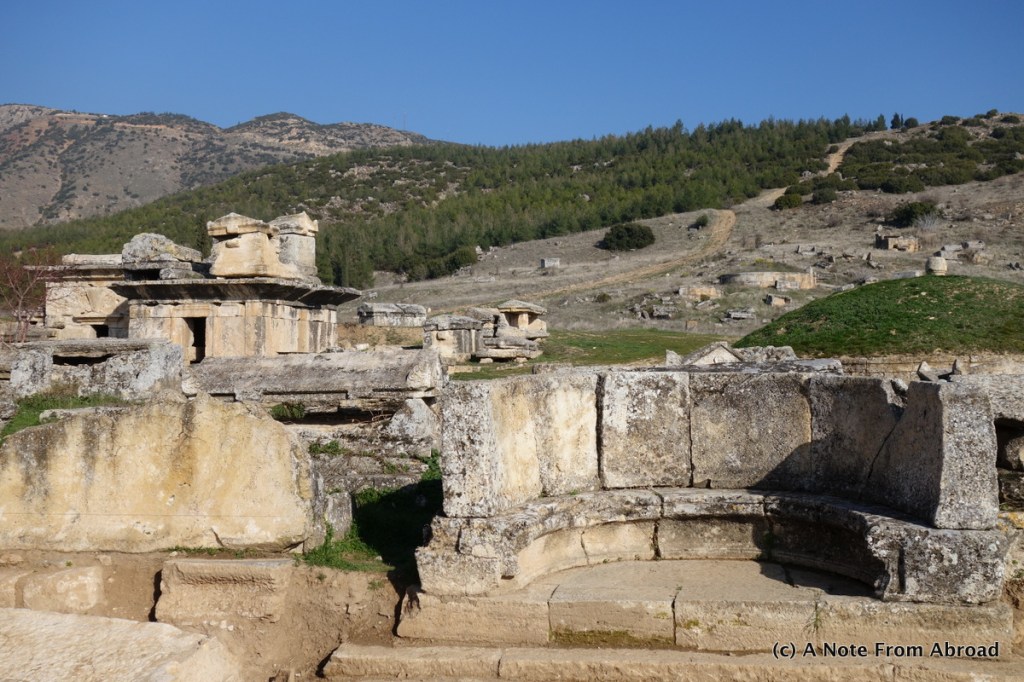
This shows an example of all three burial types 
The tomb of the curses
The Mevlâna Museum and Mausoleum, Konya, Turkey

While driving to the hotel that evening, we saw a vehicle with a draped coffin in the back and found out that Muslims are only transported to the cemetery in a coffin but are not buried in a coffin. They are wrapped in light cloth and buried directly in the soil about six feet deep. They do not do cremations there.
Kirkwall, Orkney Islands, Scotland
There is probably no more classic setting than the churchyard cemetery. Modern cemeteries were almost non-existent until the 18th and 19th century. Before that, virtuous Christian’s were buried in the consecrated churchyard. Sadly, there is a history of only the pious, important members of the town and congregation, and the rich being granted this privileged, proper burial. The poor were buried in non-church plots, sometimes stacked into communal burial pits.
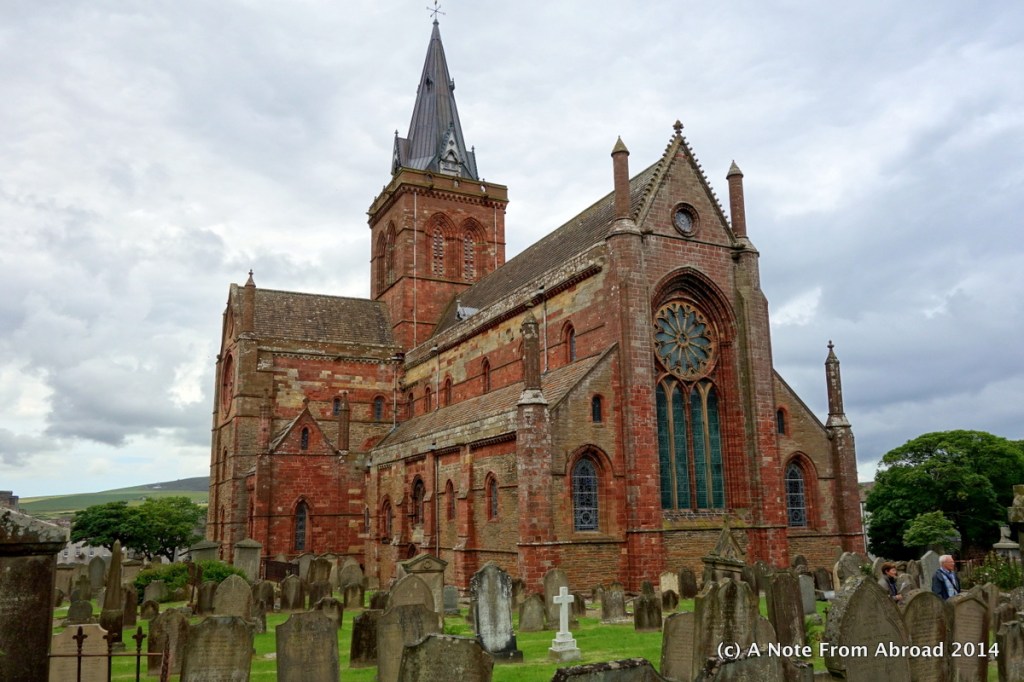
Glasnevin Cemetery, Dublin, Ireland

It may seem strange for a cemetery to be listed as a top tourist attraction in a city, but it certainly is in Dublin and comes complete with guided tours. It is listed as #4 out of 279 things to do per Trip Advisor! Tim and I took a private tour and gained admittance inside the largest monument in the cemetery – under the tower and inside the tomb of Daniel O’Connell.
O’Connell is much revered in Ireland. A staunch advocate for resolving things peacefully and via legislation, he championed the Catholics in the late 1700’s, early 1800’s, who were treated as second class citizens in Ireland.
“Prior to the establishment of Glasnevin Cemetery, Irish Catholics had no cemeteries of their own in which to bury their dead…O’Connell pushed for the opening of a burial ground in which both Irish Catholics and Protestants could give their dead dignified burial. Glasnevin Cemetery was consecrated and opened to the public for the first time on 21 February 1832.” ~ Wikipedia

Daniel O’Connell Monument is the largest tower and the center piece of the cemetery 
Under the monument – Inside the tomb
Giverny, France
After arriving in Vernon we took a short bus ride to the small town of Giverny where Claude Monet had his magnificent gardens and home. This is where many of his most famous paintings were done, including the water-lily paintings. He claimed to have two talents – painting and gardening. I would have to agree that he succeeded at both.

At the end of the small town we found an unkept cemetery where he is buried. Even one of the most famous artists in the world, can end up in a meager grave.

Evora, Portugal
The Sao Francisco Church is simple and rather unassuming from the outside. Imagine your surprise if you were not expecting to visit the famous Ossuary chapel or Capela de Ossos, whose walls are decorated with thousands of human bones and skulls.

It is rather macabre, but fascinating nonetheless. Above the door is written, “We bones that here are, for yours await”.
Normandy American Cemetery Memorial, Normandy, France

After a somber visit to Omaha Beach, we loaded onto our bus to pay our respects at the Normandy American Cemetery and Memorial. Another larger and more grand memorial was built here, the resting place for over 9000 American soldiers. Most of the graves were marked with marble crosses, row after row, line after line. The occasional Star of David marked the grave of Jewish soldiers.
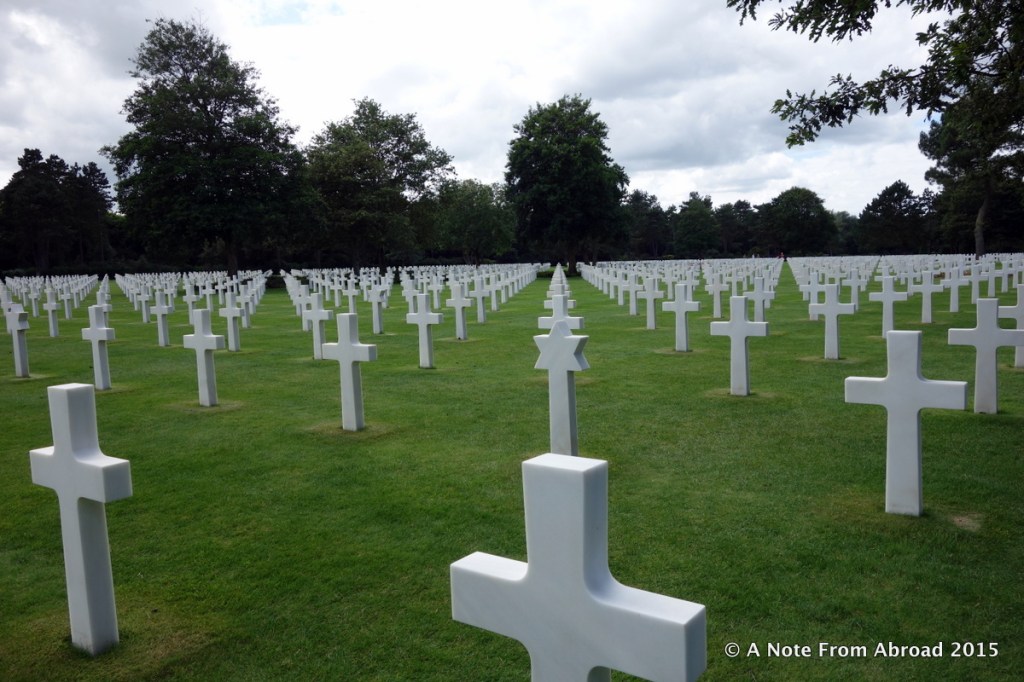
The cemetery was located on top of a hill, and when we walked along one side, we realized that we were overlooking Omaha Beach itself.
Next to the cemetery is a museum style visitors center with ongoing films and very informative displays. One of the films showed General Eisenhower being interviewed about the turmoil and decisions that led up to the D-Day invasion. Knowing he was probably sending half of these young men to their death was an almost impossible decision to make, yet he believed that the freedom of the world rested on the need to stop Hitler, at whatever cost.

Machu Picchu, Peru
This still remains one of my favorite experiences. The entire remote, lost city holds a layer of mysticism for me.
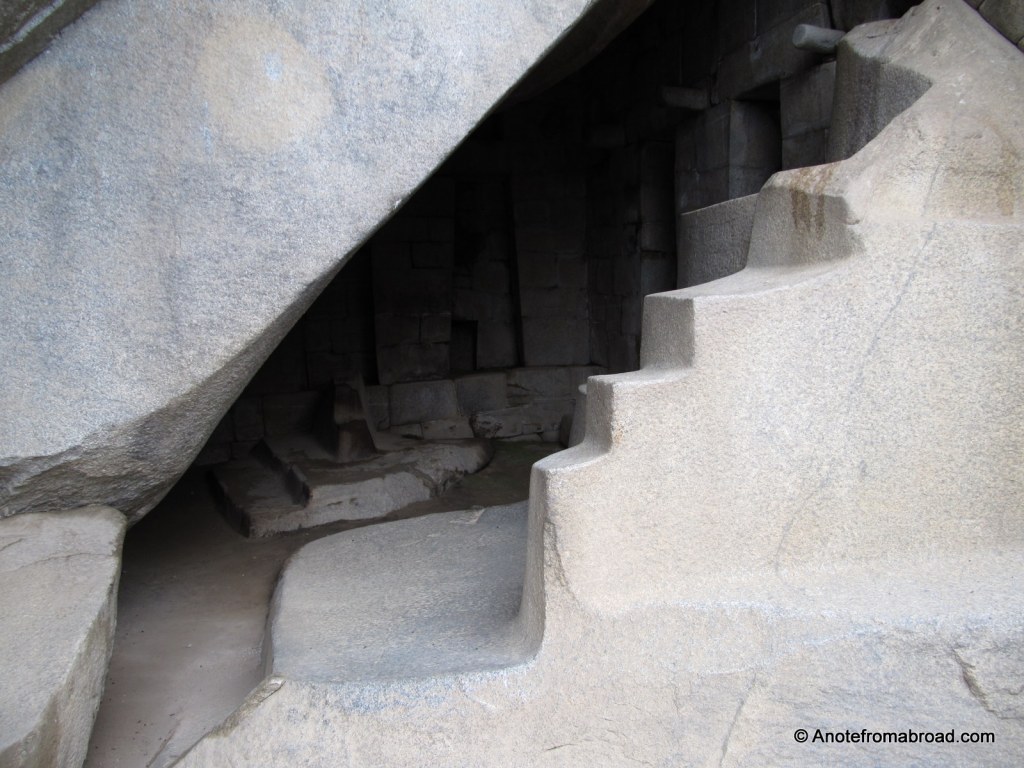
Situated below the Temple of the Sun is the Royal Tomb. Over 100 mummified skeletal remains have been found inside. What I found most interesting is that 80% of them were of women.
Liverpool, England
For any seniors who can remember the Ed Sullivan show when the Beatles had their US debut, you may find the next gravesite of interest.
When visiting Liverpool, Tim and I took what was billed as “The World’s Number One Beatles Tour”. Just across the street from where John Lennon and Paul McCartney famously met is a church and graveyard. John had been kicked out to this church for stealing money from the offering plate to buy bubble gum. In the graveyard are two tomb stones famously referenced in their hit, “Eleanor Rigby”.
Eleanor Rigby, died in the church
And was buried along with her name
Nobody came
Father McKenzie, wiping the dirt
From his hands as he walks from the grave
No one was saved ~ Metrolyrics

Father McKenzie’s grave 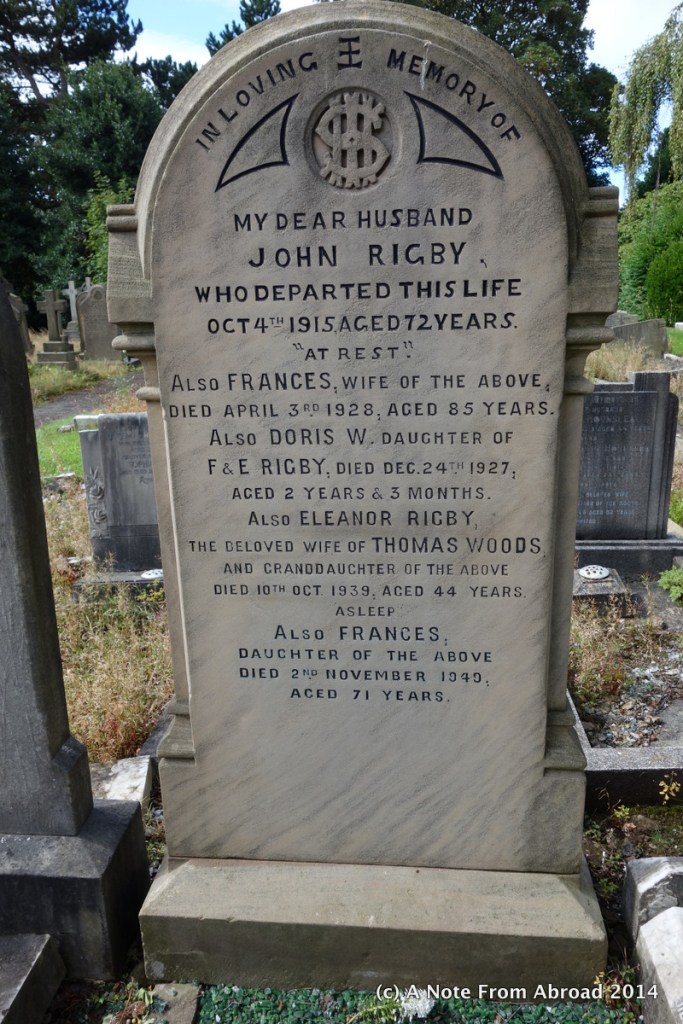
Eleanor Rigby’s Grave
Agra, India
Perhaps the most famous mausoleum in the world. Truly a monument to love, and considered by many as one of the seven wonders of the world. Built on the orders of the Mughal emperor Shah Jahan between 1631 and 1648, it stands as a memorial to his third and favorite wife, Mumtaz Mahal who died during childbirth of their 14th child.

Appenzell, Switzerland
We visited the small Alpine village of Appenzell. It is right out of storybook land. Lush green hillsides dotted with Swiss cows or the occasional goat, family homes with flower boxes beneath each window loaded with brightly colored flowers and an attached barn with shuttered windows painted contrasting shades.

The graveyard right next to the church was equally interesting. First of all the setting is “to die for” and quite lovely for an eternal resting place. The plots are very small, but each one is individually “landscaped” with a unique design. Some of the headstones are stained glass.
Zermatt, Switzerland
Zermatt is a car free resort town sitting at the base of the famous Matterhorn. Relatively small, it is easy to walk from one end to the other along the main avenue, Bahnhofstrasse. We booked two nights at the Hotel Antika which was about .4 of a mile from the train depot.
The hotel had an interesting setting. Our balconied room was overlooking the cemetery, but also right beside the river. This was the first for me.

The view out of our hotel room 
Looking straight down from our hotel balcony
Later in our stay in Zermatt, we walked through the cemetery next to the church where a special section was devoted to those who had lost their lives while mountain climbing in the area, including a tomb of the unknown climber.

Tombstone, Arizona
Boothill Graveyard was a highlight stop on our visit to Tombstone.

There is a descriptive list of the more than 250 graves that you can purchase for $3.00. It reads like an old movie script with descriptions like:
- Seymour Dye, Killed by Indians, 1882
- Geo. Johnson. Hanged by Mistake
- Delia William, 1881, Suicide
- Alfred Cantrell, Shot, 1881
- Margarita. Stabbed by Gold Dollar
- Kansas Kid, A cowboy killed in a stampede

Luxembourg American Cemetery and Memorial
The 50 acre cemetery holds the remains of 5,076 American service members, most of whom lost their lives at the Battle of the Bulge, which was fought nearby during the winter of 1944-45.
The most well-known grave is that of General Patton.
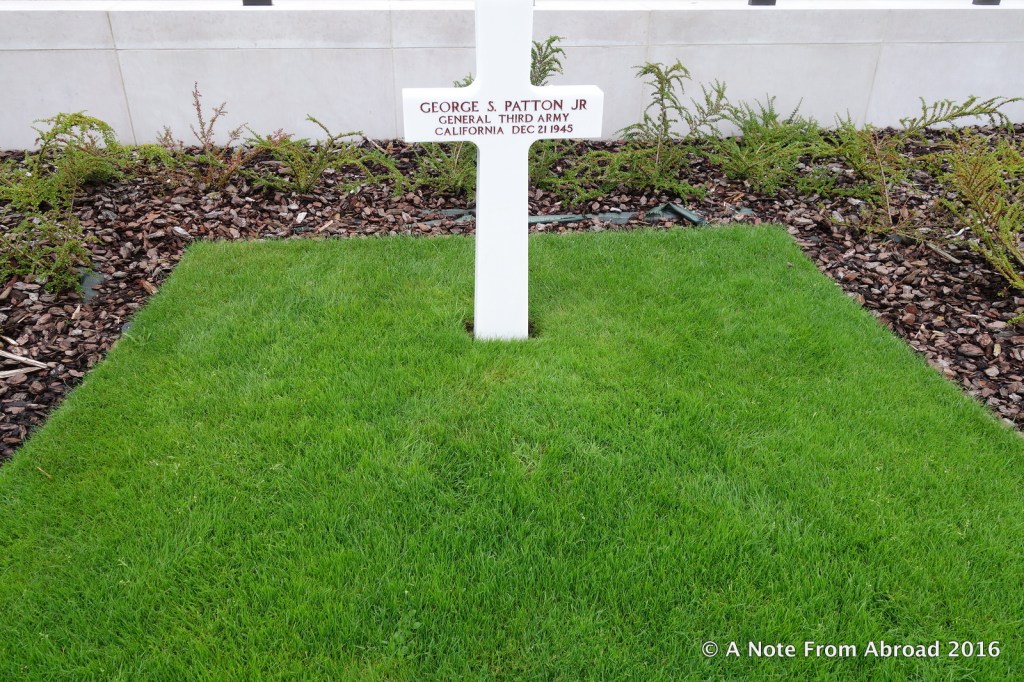
Salem, Massachusetts
The main focus of the day was to learn more about the witch hunt, trials, and the consequences that took place in this small town back in 1692. By November of 1692, twenty people were put to death, having been convicted of witchcraft. Nineteen of them were hung and one was pressed to death.

The dead were claimed by relatives and buried in unmarked spots for fear that their bodies would be dug up and torn to shreds.
Halifax, Nova Scotia
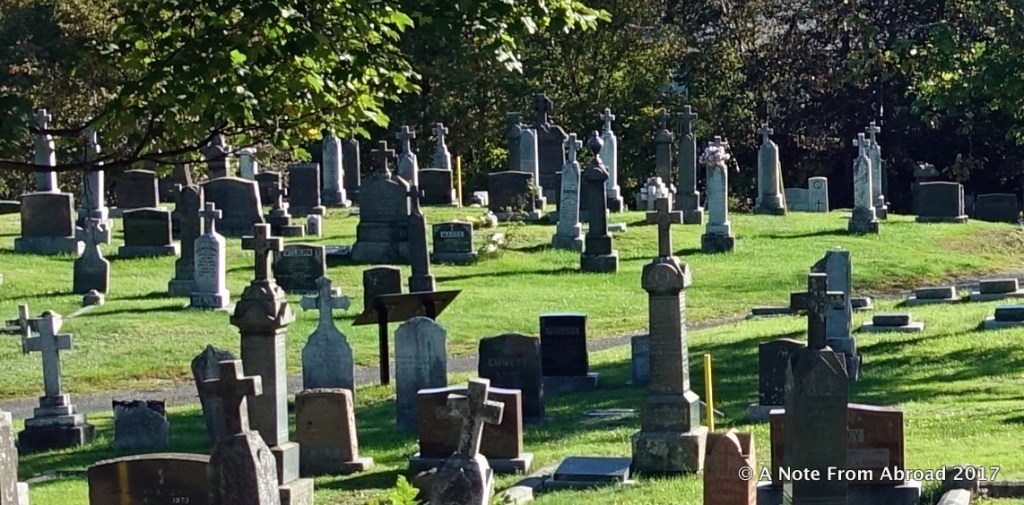
Fairview Cemetery where over 100 of the casualties from the Titanic are buried.
Cementerio General de Santiago, Santiago, Chile
This is one of the largest cemeteries in South America with over 2 million people interned. From paupers to the elite, including all but two of the former presidents are buried here. Because engraving the stones is expensive, most of the cubical style cubbyholes only contain a name and date of death.

Another very interesting thing about the cemetery, is that to save money, after a few years, space can be opened, the remains gathered and placed in a corner, then new remains can be added. It was not unusual to see two or three names on a face plate. The most buried in any one plot is twelve! When we spotted it, the picture I snapped there became my favorite of the day.
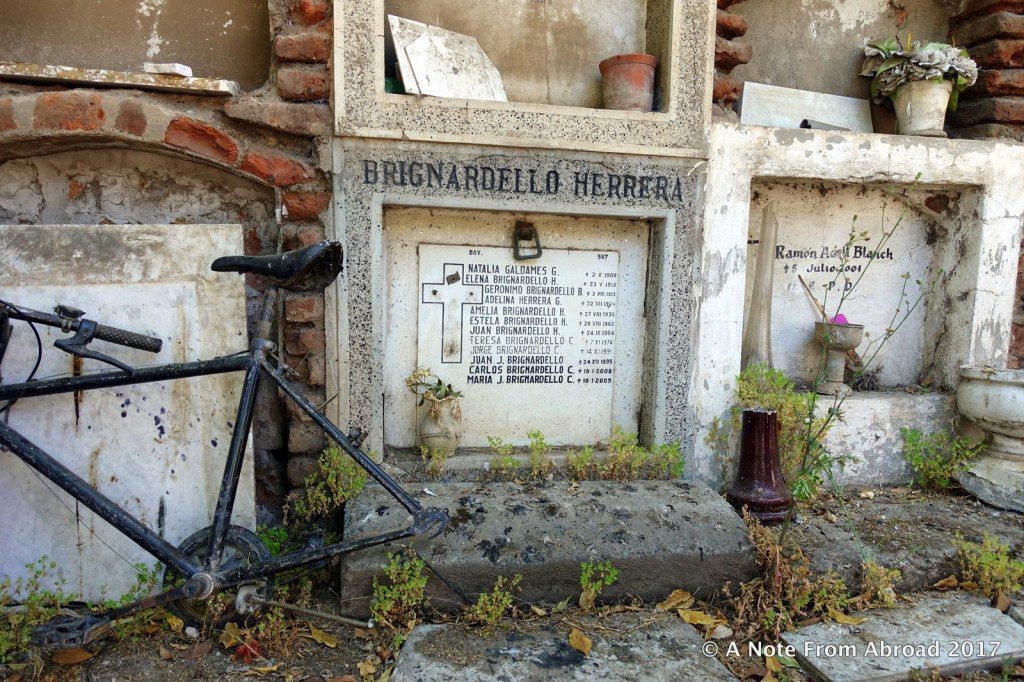
I found it fascinating that there is a rental fee that is paid yearly, and if the payment stops, the remains are moved to a common burial site. The place is enormous with 85 hectares (210 acres).
We moved into the area where larger monuments were, including entire buildings that housed members from a group or organization. And they became even more elaborate as during the time of Chile’s economic boom, it became common for the wealthy to compete for the most beautiful or unique structure in which to house their remains.
City Cemetery, Punta Arenas, Chile
The City Cemetery was an unexpected delight, lined with cypress trees and impressive mausoleums. It was voted as one of the ten most beautiful cemeteries in the world!

Vietnam
The Vietnam burial routine is that when someone dies in rural areas, the body is cleaned, placed in a coffin and then buried for three years in a marked location in the rice or planting fields.
“In some rural parts of Vietnam, especially with peasants’ families, the coffin is placed in the middle of the rice field and the dead’s eldest son has to walk backward, or even rolling on the muddy ground, to show his regret of his parent’s death.” ~ Vietnamonline.com

At the end of the three-year period, the coffin is dug up, the bones are collected, cleaned and then moved into a family plot or grave, often in a more conventional graveyard setting.
Ganges River, India
There are continuous cremation being done along the banks with the cremains then put into the river. The Hindus consider this such a holy place that many people make pilgrimages here, some specifically to live out their final moments.

It is the ultimate wish to die here, be cremated and have your ashes put into the Ganges. It is said that if that happens then the spirit reaches Nirvana and is released from earthly incarnations.
Jacksonville, OR

This small old west mining town is very close to where I grew up. Besides seeing some of the history in the area, I was both fascinated and honestly a bit appalled by the distinct areas in this cemetery. People were grouped together depending upon their ethnicity and religion. It contains some of the earliest pioneer grave sites in all of Southern Oregon. Its 32 acres currently contain over 5,615 grave sites divided into different sections. They include the Jewish (Hebrew), and Catholic sections, the Independent Order of Odd Fellows, Ancient Free and Accepted Masons, Independent and Improved Order of Red Men.
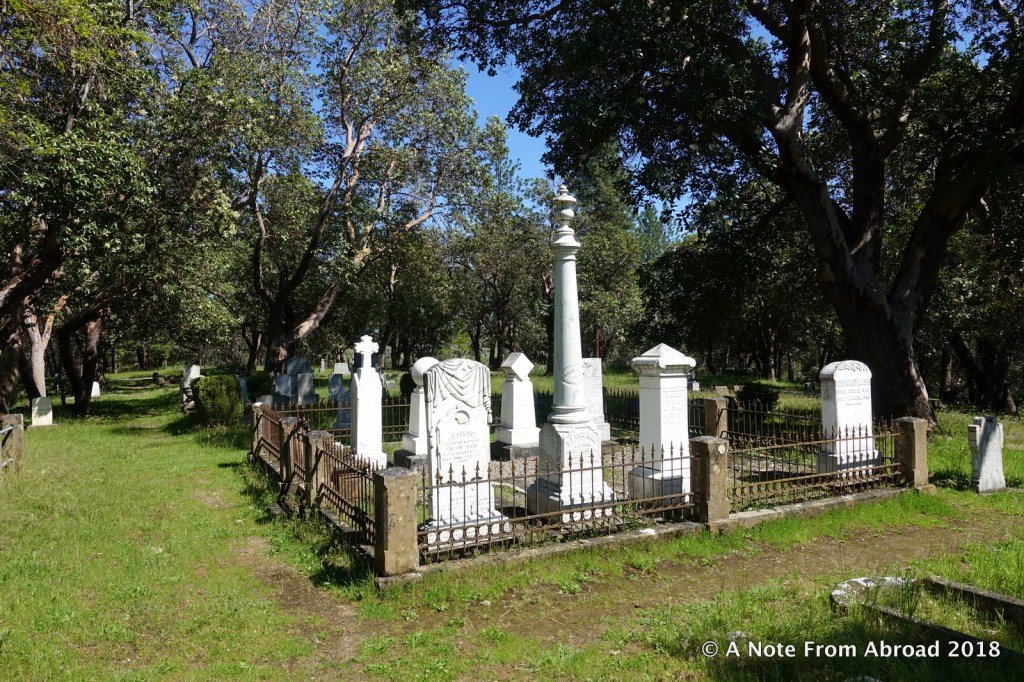
Families were often grouped together in their own fenced-in compound.
Taos, New Mexico
The old chuch and cemetery were built in 1619 by forced Native labor, the church was destroyed twice; first in 1680 during the Pueblo Revolt and again in 1847 in the Taos Revolt.
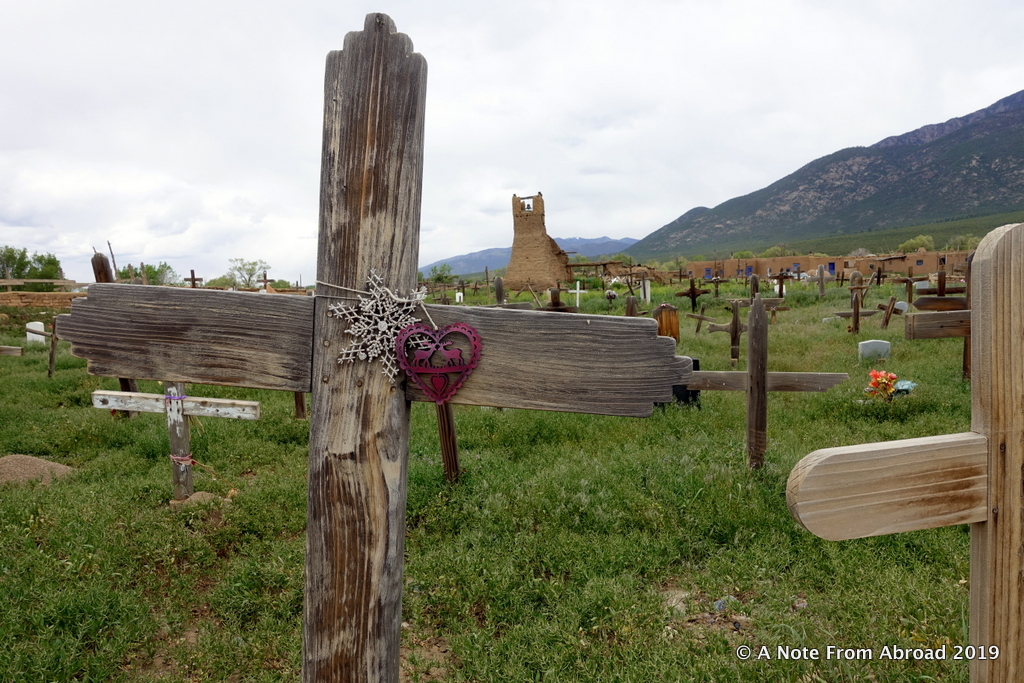
Today all that remains are simple wooden crosses.
I have saved my two favorites for last:
Père Lachaise Cemetery, Paris, France
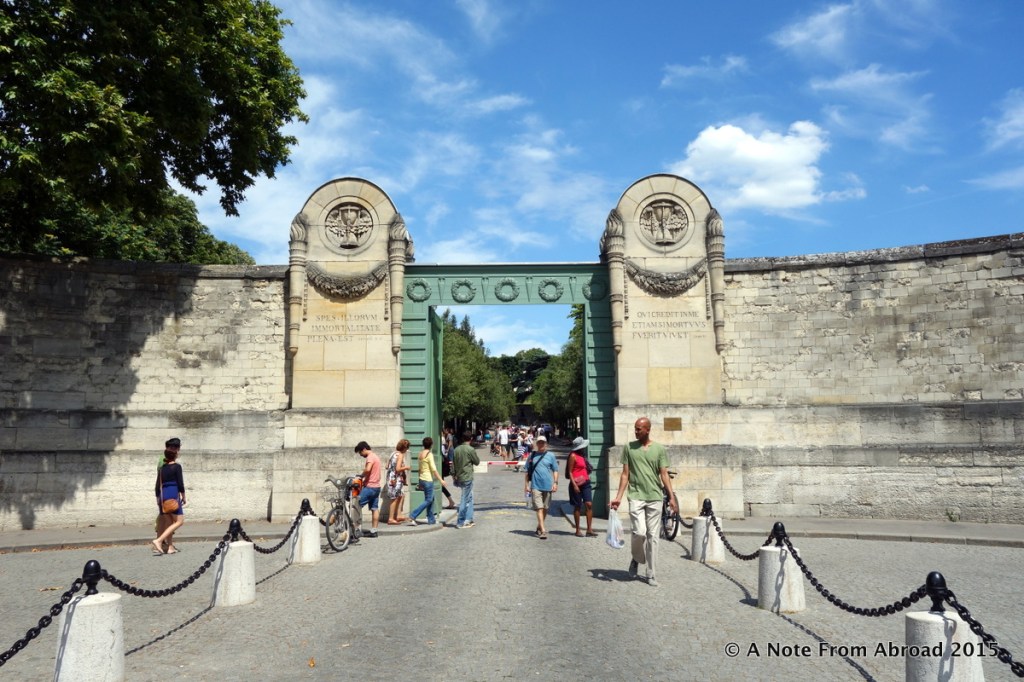
There are several large cemeteries throughout Paris, but probably the most well-known is Père Lachaise. Established in 1804 due to Napoleon’s decree that “Every citizen has the right to be buried regardless of race or religion”. Because the location was a distance from the city center and not consecrated by the church, it took several years before it became accepted.
It is still an active cemetery, although space is extremely limited. To be eligible, one must either have lived in Paris or die in Paris. Over 1 million people are currently buried here.
Among the famous names of those interred here are Oscar Wilde, Maria Callas, Frederic Chopin, Moliere, Edith Piaf, Balzac, Proust and Jim Morrison.
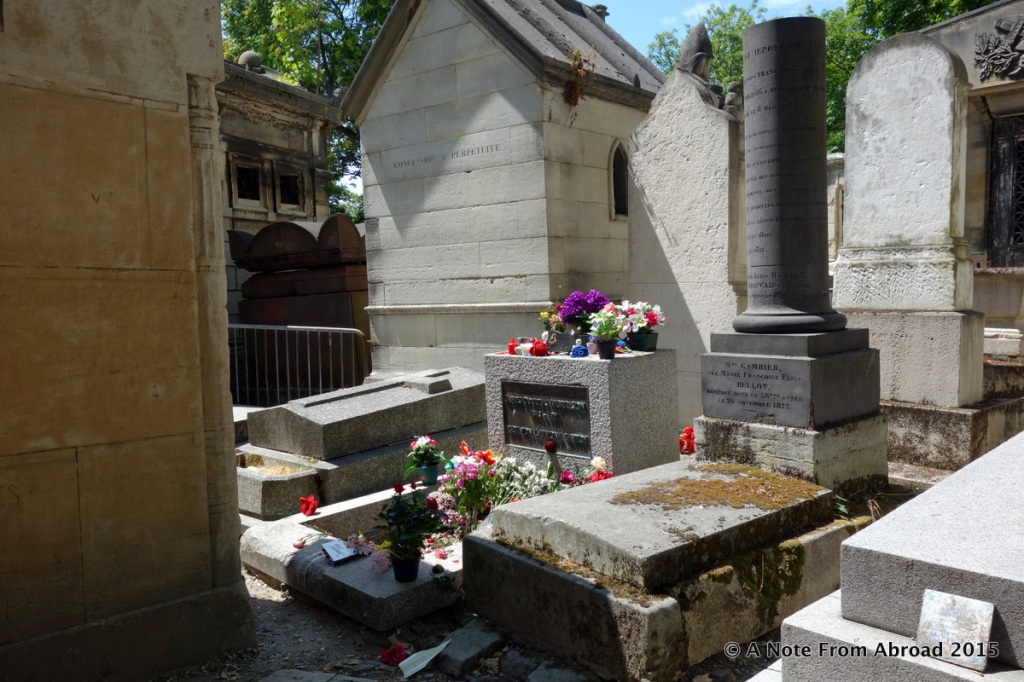
Recoleta Cemetery, Buenos Aires, Argentina
Over 6400 architecturally diverse mausoleums make up this virtual city.

Graves of some of the most notable people from Argentina are buried here, including Presidents, Nobel Prize winners and a granddaughter of Napoleon. And of course, Evita!
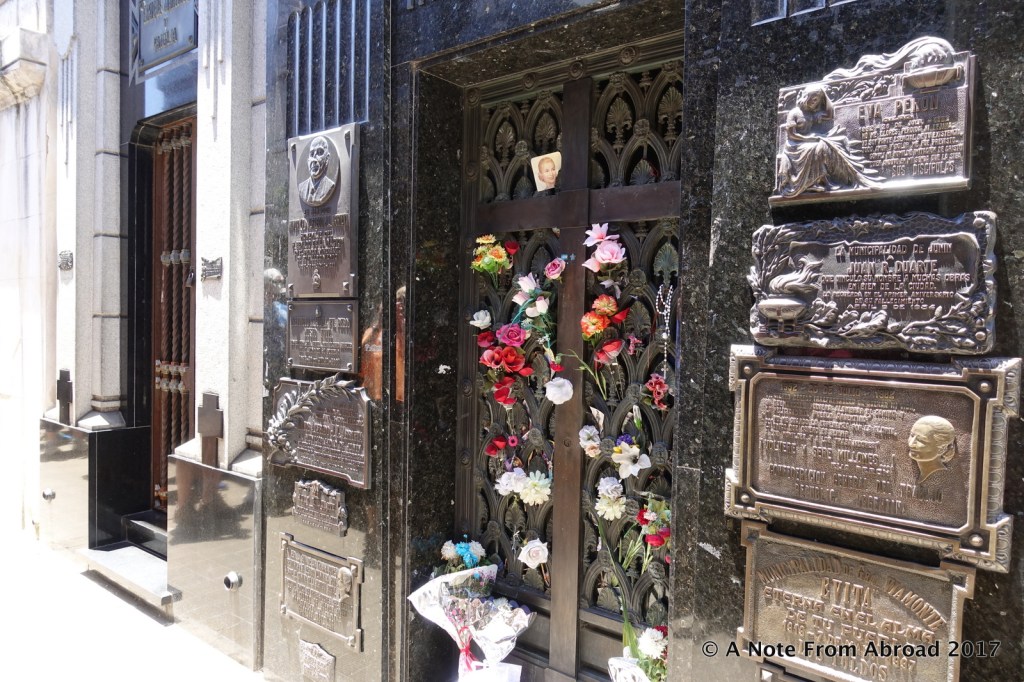
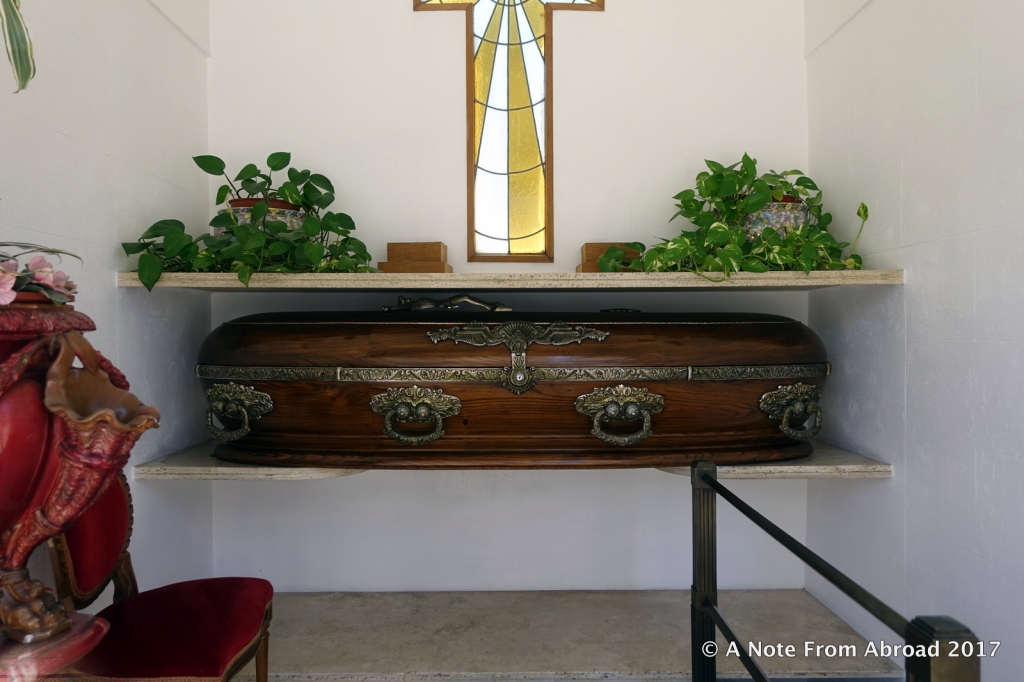
GRATITUDE MOMENT: Today I am grateful for all that I have learned regarding different burial customs around the world. I have also learned that I do not need or want any special monument or memorial when my time here is up. I am hopeful that I still have many good years ahead of me.
Please check out our new Facebook page called, “A Note From Abroad: Let’s Travel” where we post a variety of travel related topics including, travel updates, super travel deals, RVing and road trip tips and tricks, scenic pictures from our magnificent National Parks as well as favorites from around the globe. If you love to travel, are new to traveling, or simply think that someday you might like to travel, there is something here for you. Please click this link to join that group. All are welcome!



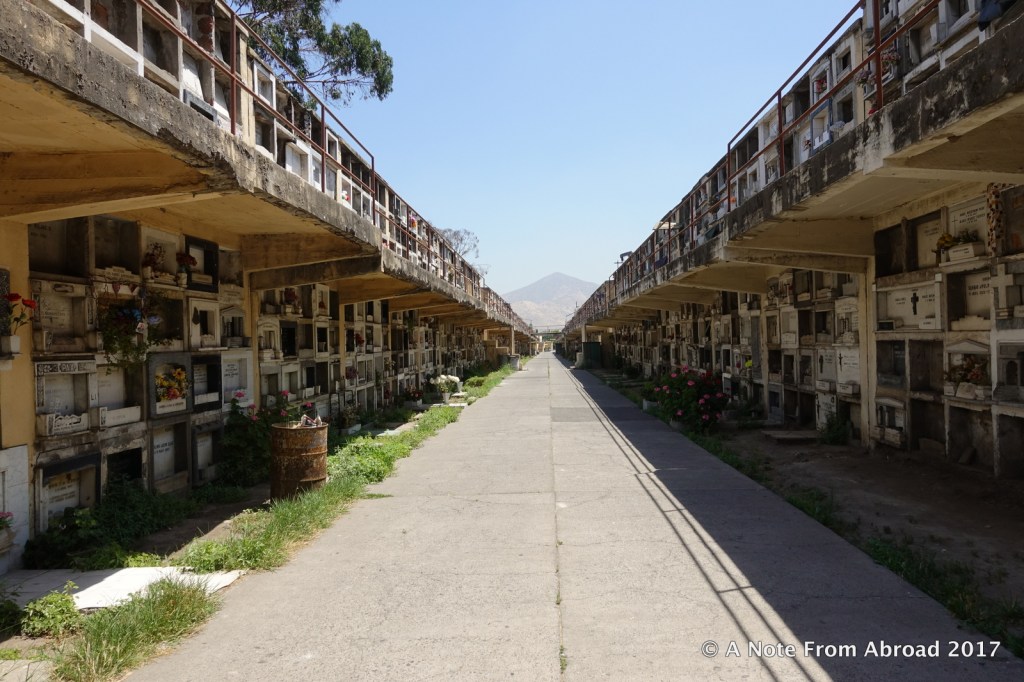
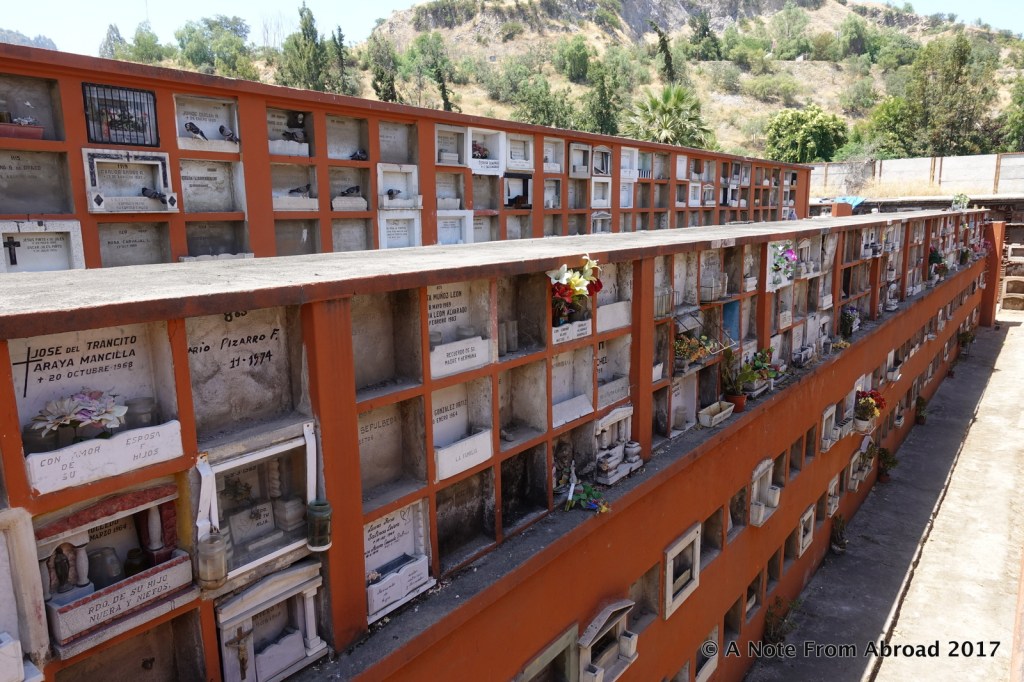
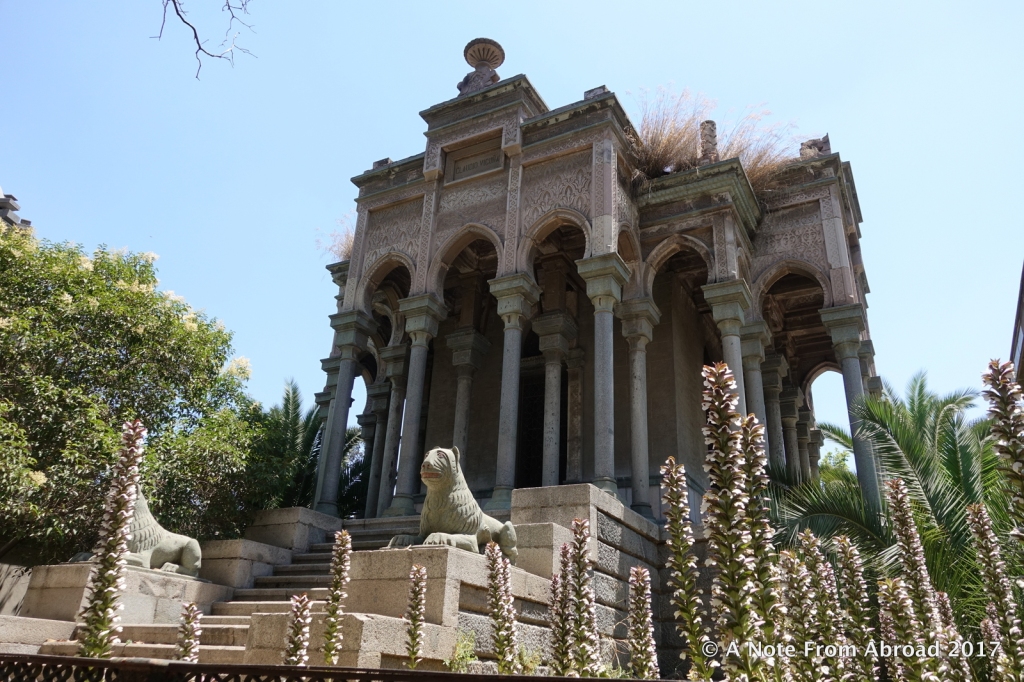

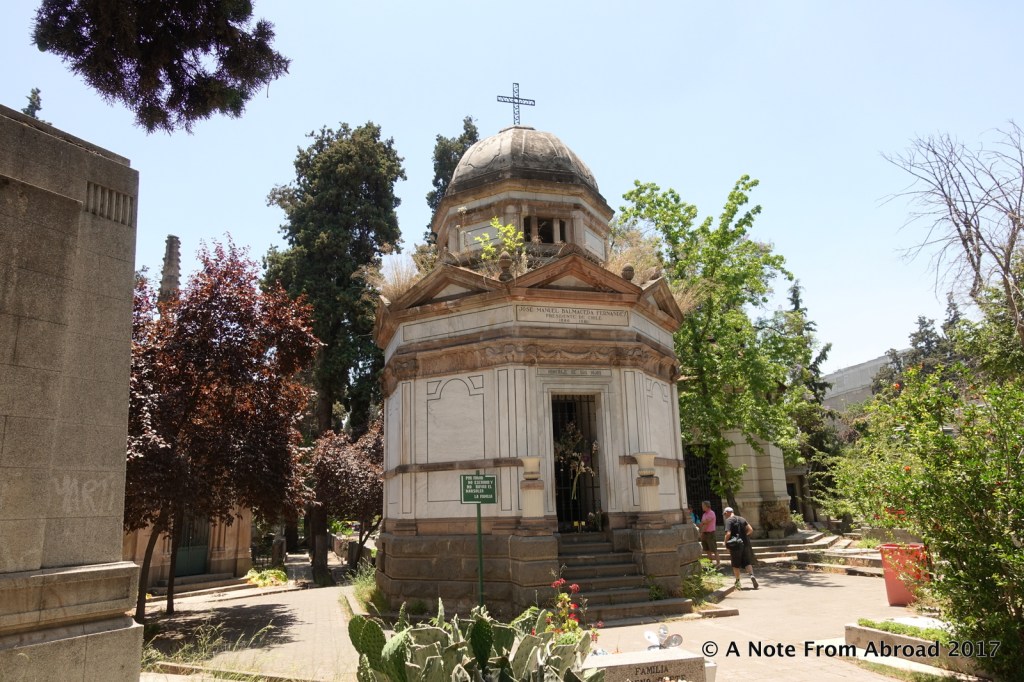
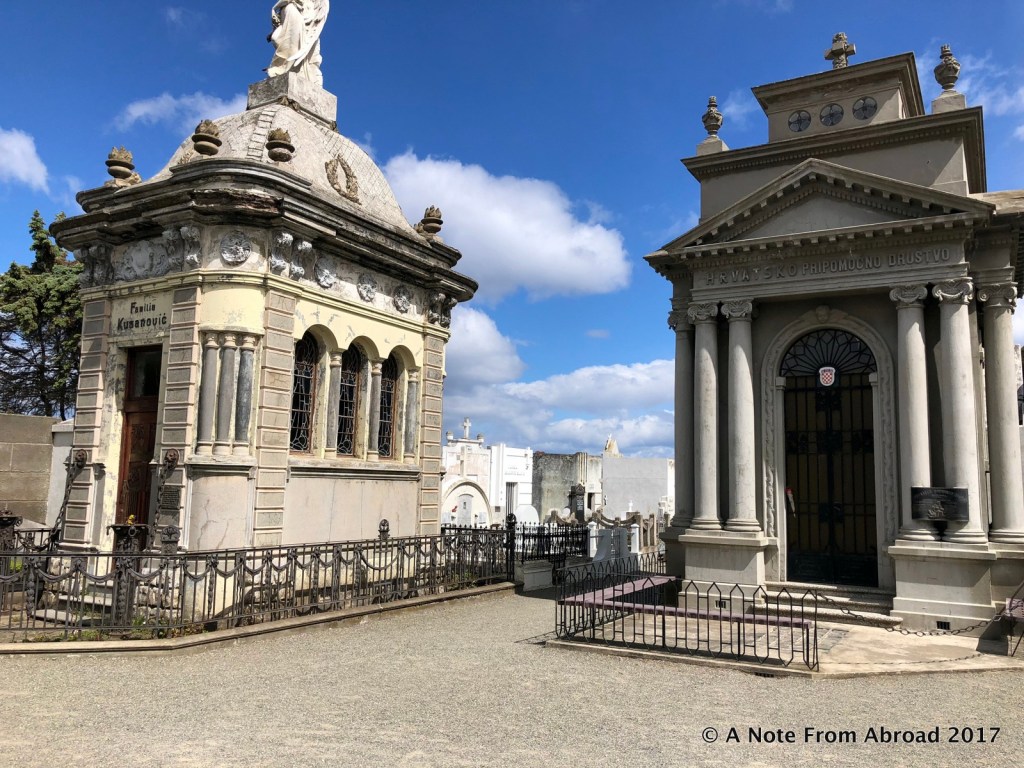


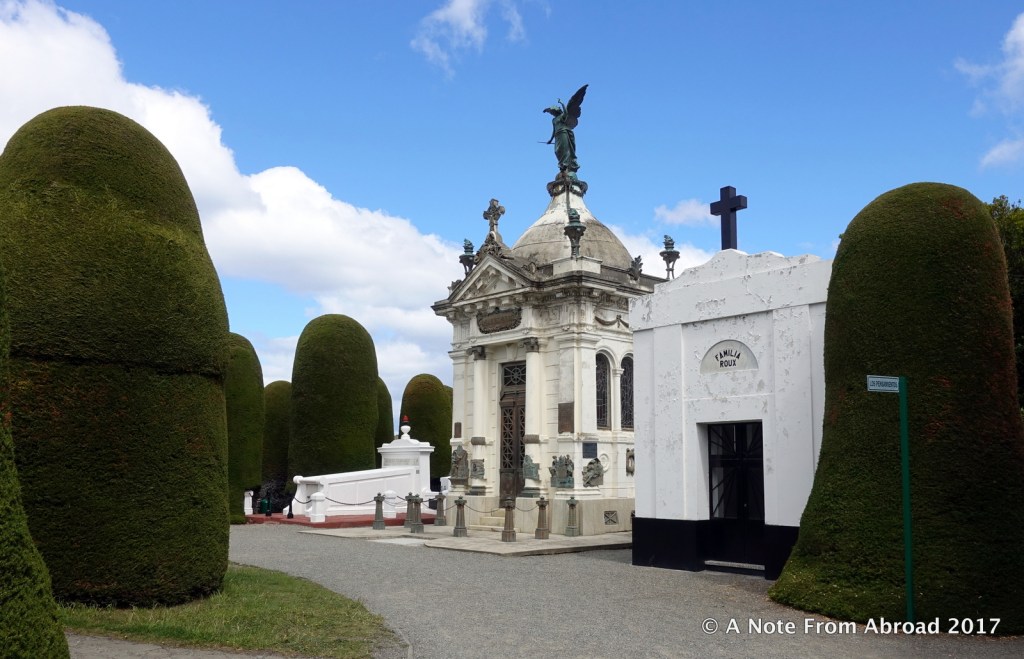

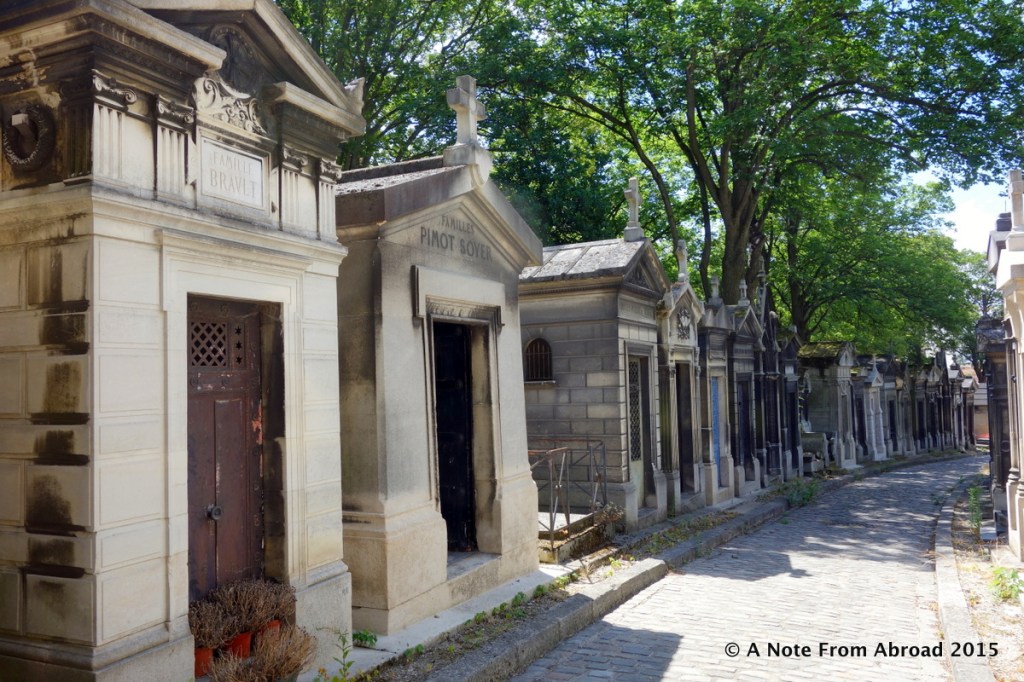






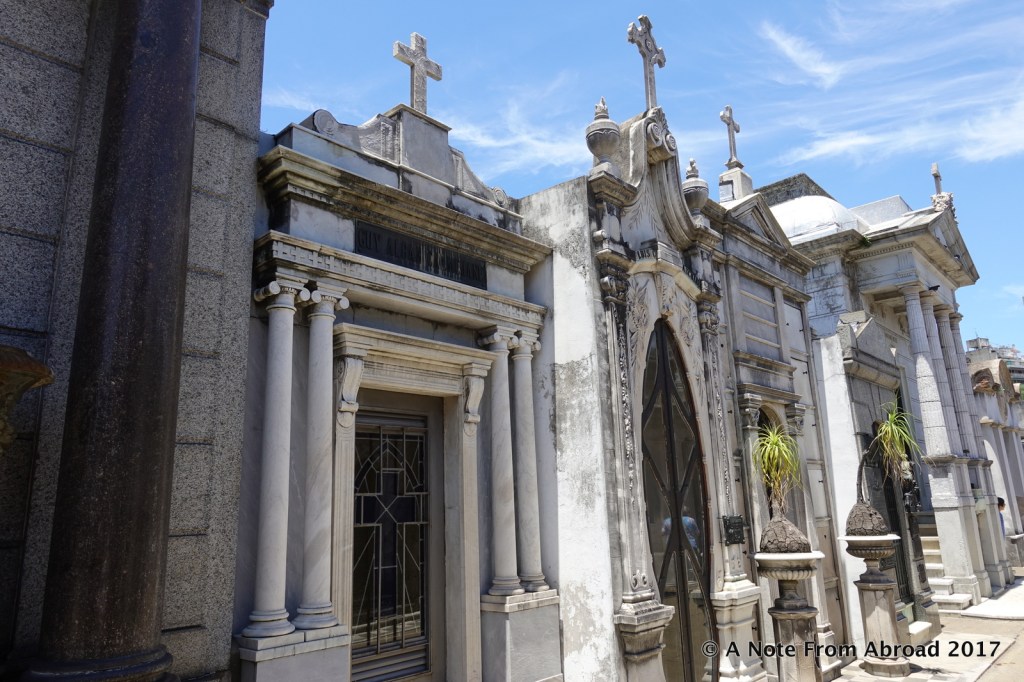

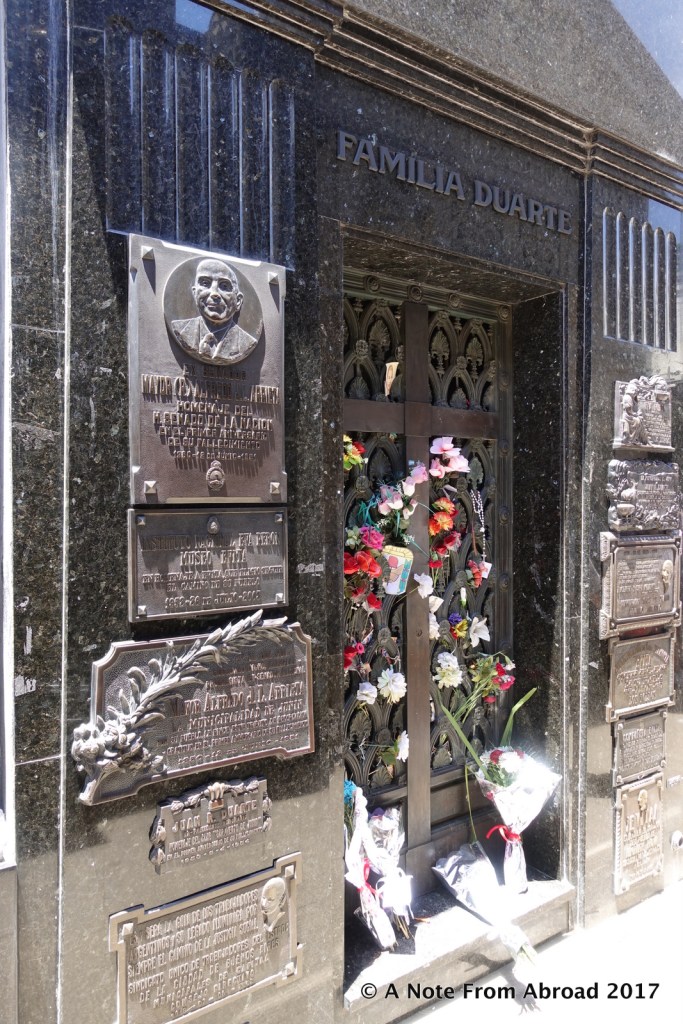

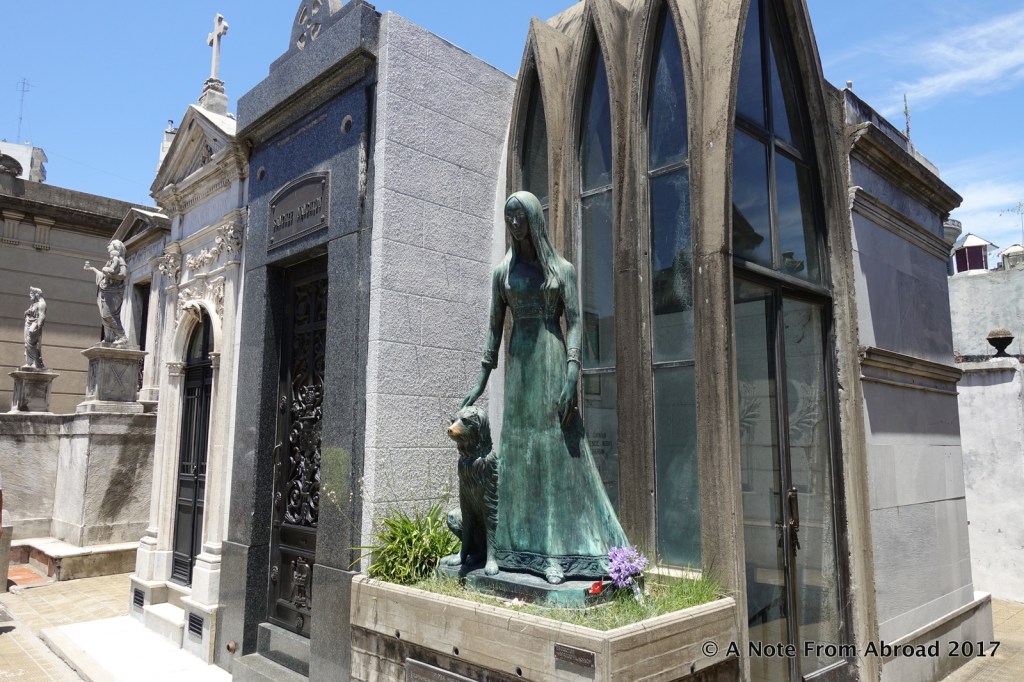




A great post with awesome pictures of cemeteries. I too enjoy visiting interesting graveyards and have been to Tombstone and the Taos graveyard. I visited a Canadian War Memorial Cemetery in Holland which was very moving. I shed a few tears. I included it in my book, Amanda in Holland. Thanks for the pictures and information.
LikeLike
Darlene, I’m glad someone else finds them worth visiting. I was initially uncertain if this was a good choice for a post, but I was hopeful that showing the wide variety of cemeteries and practices would be interesting. Please tell me a bit more about your book. Since I am currently in the process of writing two books, I’m finding the background and motivation of other writers fascinating. ~ Joanne
LikeLiked by 1 person
Good luck with your books, Joanne. I’ve written 8 books in a travel adventure series for kids, but adults enjoy them too. There is more about my books on my website http://www.darlenefoster.ca and on my blog https://darlenefoster.wordpress.com/ If you have any questions, please ask.
LikeLike
I just checked out your book series and they look so fun! What a wonderful way to introduce children to a world of adventure and traveling. I see that the latest, book 8 has just been released on Amazon. Congratulations on this series!
LikeLike
After numerous tries, this page still hasn’t loaded completely, although I saw some complete photos, some partial, and some just the explanation. You covered a lot here. We’ve always loved old cemeteries and had a marvelous one near us in Cleveland. I’ve see the Lester Moore one and love that and we also saw the one at Omaha Beach as well as many others in that area, American, British, Canadian, and even German. Quite a sobering experience. There are single monuments all over France that list the name of people killed in WWI a/o WWII, sometimes the entire male side of families. I like those because we need to remember.
janet
LikeLiked by 1 person
Janet, I’m sorry that this refused to load properly for you. It was a lot of information as well as quite a few pictures. Seeing memorials where the entire line of males in a family were killed is sobering to say the least. My dad’s brother was killed in WWII and when we were in France I asked for information at the memorial and found out that he is buried in Italy. I will have to look up the Lester Moore cemetery. ~ JJ
LikeLike
Lester’s in Boothill near Tombstone. You have the marker in your post. I should have looked at it on my phone. That loaded up right away. Lovely shots and I enjoyed the information.
LikeLike
One of the first things I do when visiting a new to me place is to see where the cemetery is located. I love the history and beauty of graveyards. You have some wonderful ones here that I will make note of. Two of my favorites so far are the large cemetery near Havana, Cuba and the National cemetery in Oaxaca, Mexico.
LikeLiked by 1 person
Thank you for sharing your favorites. We have been to Havana, but we’re only there a few days and did not make it to the cemetery. I’m curious as to what made both of these two stand out for you?
LikeLiked by 1 person
That’s a great question that I’m not sure I can answer. I love cemeteries that aren’t tidy. I like a hodge podge of grave stones and mausoleums, statues and markers. The older, the better.
LikeLike
I too like the older graveyards. There is so much history and variety there.
LikeLike
I remember arriving at the American Cemetery late in the day on our Battle Bus tour when flag retreat was taking place. It was a humbling experience before walking the cemetery.
LikeLike
Terry, were you traveling with other former vets? I think that would be especially meaningful and memorable.
LikeLike
No just my wife and I. It was an amazing tour we had with just 2 other couples and a very informative guide.
LikeLike
LOOKS LIKE BOOK ,MATERIAL TO ME. FASCINATING!
LikeLike
Thank you! I’m glad you found it interesting ❤
LikeLike
This was absolutely fascinating Joanne.
LikeLike
Thank you Mike. I found the variety of grave markers and burial customs quite interesting too.
LikeLike
I have goosebumps right now! Steve and I love to visit cemeteries when we travel–and the older the more interesting to us. Thank you for sharing all of these places I have not been, excluding Tombstone, AZ.
Your photos and description are fascinating. You have many roles I value, and teacher is definitely one of them. Yours is a “classroom” I want to attend, listen, learn and feel motivated to travel the world.
Thank you for sharing your love of history, adventure, photography, writing, and traveling with us. I am so grateful!
LikeLike
Brenda, you always say the nicest things. I’m grateful for your friendship and for the love and gentleness that permeates all that you do. Thank you 😊 ❤️♥️❤️
LikeLike
Great idea for a post! Burial customs and sites are so fascinating and as you’ve shown make for wonderful photos. I wish I had visited the cemetery in Paris as I loved Recoleta in Buenos Aires.
LikeLike
Those are all so beautiful, but we are running out of room, for the dead.
LikeLike
In some areas this definitely true. I was so saddened to see the Ganges River situation now with COVID in India.
LikeLike